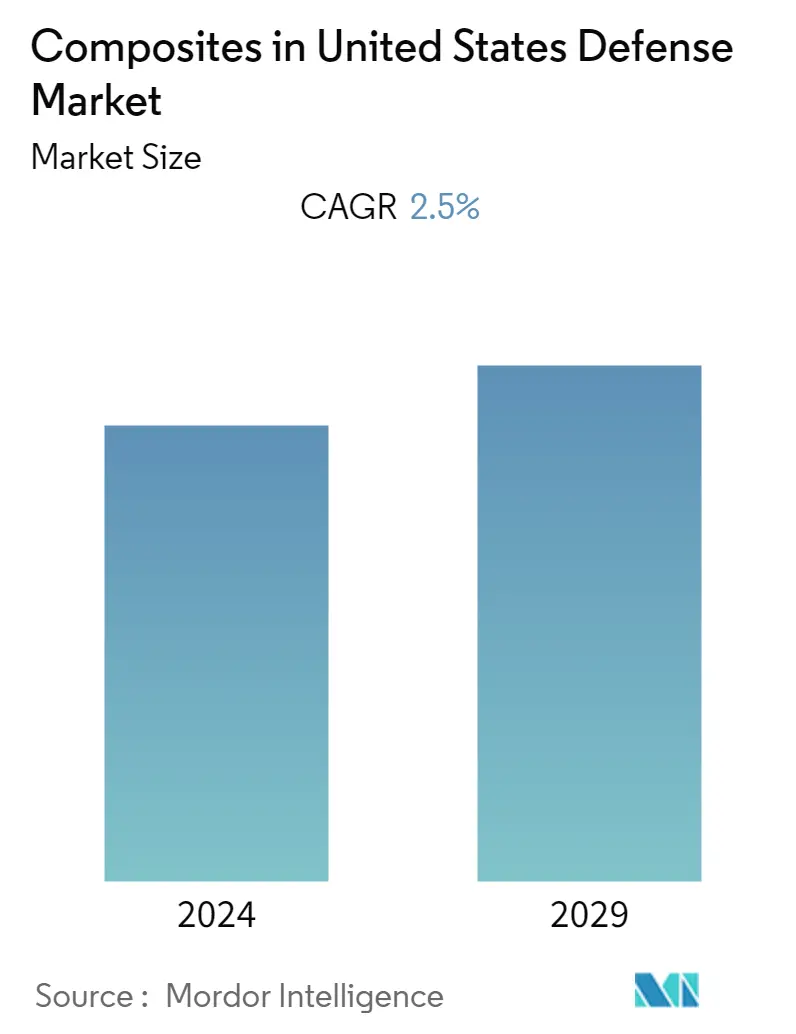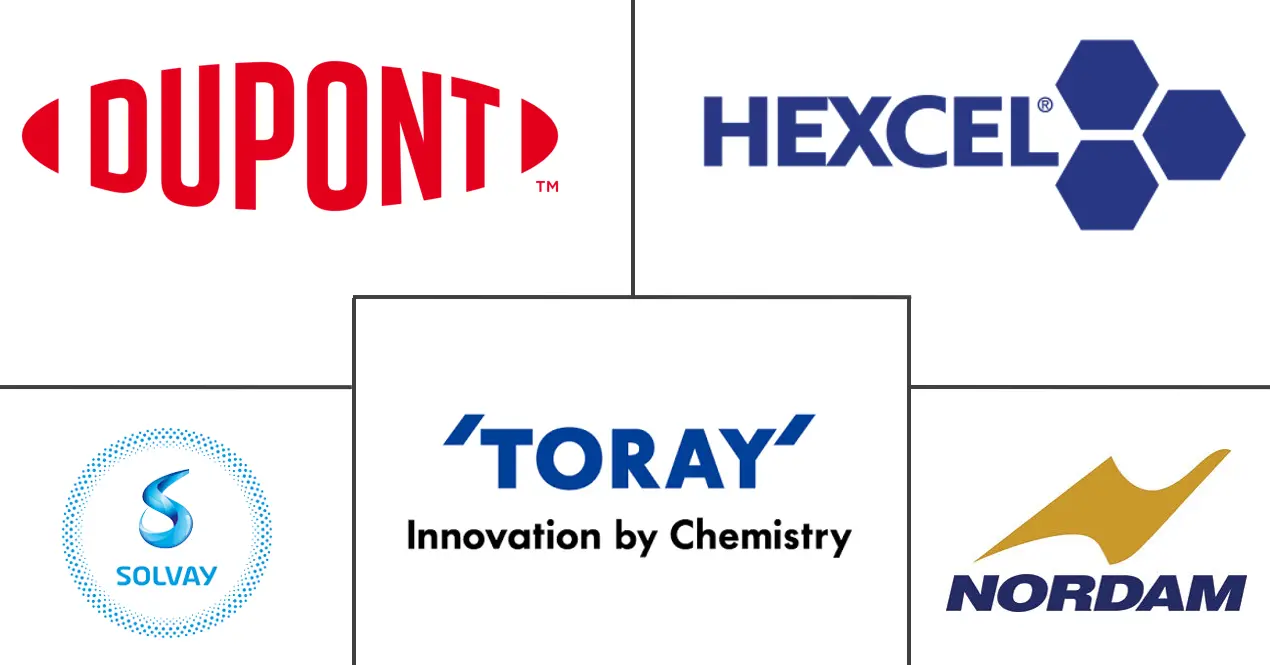Market Size of Composites in United States Defense Industry

| Study Period | 2019 - 2029 |
| Base Year For Estimation | 2023 |
| Forecast Data Period | 2024 - 2029 |
| Historical Data Period | 2019 - 2022 |
| CAGR | 2.50 % |
Major Players
*Disclaimer: Major Players sorted in no particular order |
US Defense Composites Market Analysis
The Composites in United States defense market was valued at USD 2,968 million in 2020, and it is projected to reach USD 3,413 million by 2026, registering a CAGR of 2.5% during the forecast period (2021-2026).
The outbreak of COVID-19 and the subsequent shutdowns have affected the defense manufacturing sector in the country. The negative impacts of the pandemic are clearly visible in the supply chains of several players, as several programs rely on a uniquely global network of part suppliers. Though the government and defense companies have tried their best to avoid disruptions, the pandemic has impacted production in several facilities. Furthermore, the advent of the second wave of COVID-19 in several regions across the world remains a concern for the market players.
The United States has been investing billions in the development of newer generation military platforms, vehicles, and offensive and defensive systems to enhance the mission readiness of its armed forces and maintain its technological superiority. Most of these newer generation weapon systems feature increased use of composite materials. Such procurements are expected to propel the growth of the market during the forecast period.
In addition to procurement, the US government also funds several research programs that focus on developing future military systems using advanced non-traditional materials like composite materials. This is expected to bolster the market prospects during the forecast period.
US Defense Composites Industry Segmentation
A composite material can be defined as a material developed by combining two materials with different physical and chemical properties. The study includes all types of composites used in military applications. The market is segmented based on application into manned and unmanned aircraft, naval ships, land vehicles, protective equipment, and other applications. Both fixed-wing aircraft and rotorcraft are included under the manned and unmanned aircraft segment. The market is also segmented by resin type into thermoset composites, thermoplastic composites, and ceramic matrix composites. The market sizing and forecasts have been provided in value (USD million).
| Application | |
| Manned and Unmanned Aircraft | |
| Naval Ships | |
| Land Vehicles | |
| Protective Equipment | |
| Other Applications |
| Resin Type | |
| Thermoset Composites | |
| Thermoplastic Composites | |
| Ceramic Matrix Composites |
Composites in United States Defense Market Size Summary
The United States defense composites market is poised for growth, driven by significant investments in advanced military platforms and systems. The market is characterized by the increasing integration of composite materials in various defense applications, particularly in the development of newer generation weapon systems. These materials are favored for their lightweight, high-strength, and corrosion-resistant properties, which are essential for enhancing the performance and durability of military equipment. The market's expansion is further supported by government funding for research programs aimed at developing future military systems using advanced non-traditional materials. The thermoplastic and thermoset composites segments are expected to experience substantial growth, with thermoset composites being extensively used in military aircraft construction due to their superior performance benefits over metals and alloys.
The manned and unmanned aircraft segment currently leads the market, with advancements in composite technology enabling the production of lighter, faster, and stronger aircraft. The US military's focus on replacing traditional materials like aluminum and titanium alloys with composites is anticipated to drive further market growth. Key players in the market, such as Solvay SA, Hexcel Corporation, and DuPont, are actively involved in providing composite materials and participating in research and development programs. Long-term contracts and strategic acquisitions are expected to bolster their market positions. Additionally, government initiatives and funding, such as those from the Department of Defense and the Combating Terrorism Technical Support Office, are supporting the development and production of advanced composite materials for military applications, further contributing to the market's growth trajectory.
Composites in United States Defense Market Size - Table of Contents
-
1. MARKET DYNAMICS
-
1.1 Market Overview
-
1.2 Market Drivers
-
1.3 Market Restraints
-
1.4 Porter's Five Forces Analysis
-
1.4.1 Bargaining Power of Buyers/Consumers
-
1.4.2 Bargaining Power of Suppliers
-
1.4.3 Threat of New Entrants
-
1.4.4 Threat of Substitute Products
-
1.4.5 Intensity of Competitive Rivalry
-
-
-
2. MARKET SEGMENTATION (Market Size by Value - USD million)
-
2.1 Application
-
2.1.1 Manned and Unmanned Aircraft
-
2.1.2 Naval Ships
-
2.1.3 Land Vehicles
-
2.1.4 Protective Equipment
-
2.1.5 Other Applications
-
-
2.2 Resin Type
-
2.2.1 Thermoset Composites
-
2.2.2 Thermoplastic Composites
-
2.2.3 Ceramic Matrix Composites
-
-
Composites in United States Defense Market Size FAQs
What is the current Composites in United States Defense Market size?
The Composites in United States Defense Market is projected to register a CAGR of 2.5% during the forecast period (2024-2029)
Who are the key players in Composites in United States Defense Market?
Solvay SA, Hexcel Corporation, Toray Industries Inc., DuPont and The NORDAM Group LLC are the major companies operating in the Composites in United States Defense Market.

